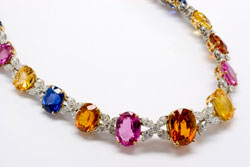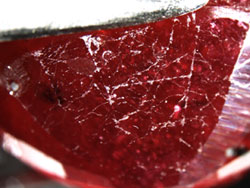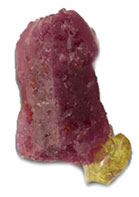Changing colors and making gems:
Are we seeing “beautiful lies”?
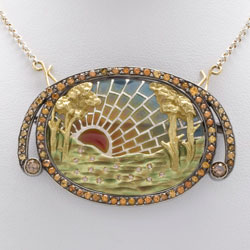 Gems are usually chosen for their beauty, and then many undergo various enhancements to make them even more beautiful. But can an ugly-duckling stone become a gem? These days, the answer seems to be yes.
Gems are usually chosen for their beauty, and then many undergo various enhancements to make them even more beautiful. But can an ugly-duckling stone become a gem? These days, the answer seems to be yes.
Gem enhancements have been around for a long, long time. And they’ve been controversial at least as far back as the 1st century AD, when Pliny the Elder called gem treatments tantamount to fraud.
Since then—and especially in the last couple of decades—the number and variety of treatments have exploded, and so have the disputes and controversies about them. For gemologists, it may be a matter of truth and beauty; for gem suppliers and retailers, the issue is ethics; for insurers, it’s about valuation.
The purpose of enhancements is to improve the appearance of a gem. Heating and oiling are common treatments to enrich the color of a gem or to make its blemishes less apparent.
Today, many stones undergo treatments so extensive that they call into question the definition of “gem.” Advanced treatments can transform near-worthless material into salable merchandise. Gemologist Stuart Robertson, writing in a jewelry trade journal, calls such products “beautiful lies.”
Enhancing Rubies & Sapphires
A particular victim of extensive treatments is corundum. Natural corundum comes in a vast spectrum of colors, ruby being the name for red corundum and sapphire the name given to all the many other colors of corundum. But fine quality corundum in deep, rich colors is increasingly difficult to find. That scarcity is driving up prices, even as consumer demand increases.
Heat treatment comes to the rescue. Heat can conceal fractures and improve the stone’s clarity, rendering marketable a large amount of rough that would otherwise have been unsalable. Heat can also enhance or change a stone’s color, converting off-purple sapphires to pure pink, or pale yellow to a golden yellow. One estimate has it that 94% of the sapphires on the market today have been heat-treated. Often these gems are sold without the treatments being disclosed.
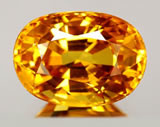  Beryllium-diffused sapphire sold with disclosure by GemSelect. |
Beryllium diffusion (also called lattice diffusion) is a newer, more controversial, approach to color enhancement. In this treatment, a faceted stone is exposed to beryllium at high heat and the beryllium infuses the stone, enriching its color. Early efforts produced color only on the gem’s surface, and such surface diffusion was easily detected. If the stone were damaged or recut, its original color would show.
In the last decade, however, scientists discovered that if they heated the stone to a very high temperature for a long duration, the beryllium would penetrate the entire stone. Typically, the treatment reduces the blue component and consequently produces bright yellows, oranges or reds, depending on the stone’s original color. It can even create the much-admired phenomenon of asterism. This advanced beryllium diffusion treatment is permanent and said to be difficult to detect.
Some high-end jewelers will not carry beryllium-diffused gems, holding that the treatment creates a processed, synthetic color not suitable for quality jewelry. The original material was not gem quality, so the treatment in effect created a “gem” where one did not exist before.
The issue of “gem-ness” is not just theoretical but economic, because when properly disclosed, beryllium-diffused corundum sells for a fraction of the price of its natural counterparts. But many of these treated stones enter the market without proper disclosure.
Non-Disclosure = Fraud
The treatment as such is not the issue. Gem treatments have made gemstone jewelry available to a greater number of people. Treatments create attractive stones, the retailer offers an array of products, and the consumer buys jewelry she likes.
The problem is disclosure. If treatments are not disclosed, the treated gems are competing in the marketplace with unenhanced, much more valuable, rubies and sapphires. If treated gems are priced on a par with untreated gems, the customer is cheated. And if an insurer replaces a treated stone with an untreated one, the insurer is cheated.
This kind of fraud is increasingly difficult to prevent. Treatments now routinely occur far up the selling chain, often before the stone is even cut. The gem supplier may not disclose the treatments, the dealer may not ask questions, the jewelry retailer may not inquire. Lack of disclosure means fraud could occur anywhere along the selling chain.
Consumers, at the end of the selling chain, may not understand the effect of treatments. Even if they are told that most gems are treated, they probably don’t understand how drastically treatments can alter a gem’s appearance. They probably don’t appreciate how huge can be the difference in value between treated and untreated gems.
Composite ruby
The most egregious recent development that really deserves the term “beautiful lie” is the composite ruby. We’ve reported on lead-glass filled ruby in detail before. The subject bears mentioning again because colored gems are so popular and because advances in technology are always pushing the envelope of what can be sold as gems.
The composite ruby is severely fractured corundum whose fractures are filled with lead glass. Some are more glass than ruby, with the glass acting as a bonding agent.
The stone may pass at a distance, but under a microscope it appears as the conglomerate it is.
Such stones require very special care. Researchers have found that when a filled stone is heated to high temperature, the filler begins "sweating" and after a few moments flows out of the stone.
The filler also becomes damaged when exposed to solutions used for cleaning gems, and is even harmed by common household products such as bleach, ammonia and lemon juice. Once the filling breaks down, the stone's fractures are again visible; in extreme cases, the pieces of the stone may come apart.
A class-action suit was brought against Macy’s for selling such stones without disclosure. If a prominent retailer like Macy’s is willing to take this risk, you can be sure other retailers are as well.
FOR AGENTS & UNDERWRITERS
Keep on file all documentation for scheduled jewelry, including the sales receipt. Be sure to get a detailed appraisal, preferably on JISO 78/79, from an appraiser who is not the seller.
For rubies and other colored stones, it is essential that the appraisal be written by a gemologist experienced with colored gemstones and familiar with the current pricing, treatments and frauds. Most jewelers deal primarily with diamonds, and even a trained gemologist may have little experience with colored stones.
For ruby, all treatments other than heating should be disclosed on the appraisal. (Heat treatment may also be listed, but ruby is assumed to be heat-treated unless the appraisal specifies it has not been.)
If a gem is not treated, that should be specifically stated on the appraisal. A treated stone has only a fraction of the value of an untreated gem of similar appearance.
FOR ADJUSTERS
In damage claims, have the jewelry examined by an independent gemologist to verify the jewelry's quality and the truth of the appraisal. The exam might reveal, for example, that the stone was treated and the treatment broke down; this is damage for which the insurer is not liable.
Examine the appraisal for words such as composite, treated, fracture-filled, enhanced, synthetic, lab-grown, Be treated, Be heated, beryllium infused, lattice infusion, or other qualifying terms that suggest the stone is other than natural, untreated ruby. Treated stones are worth a fraction of the value of natural gems of similar appearance.
Just for comparison—one source gives these wholesale values:
| high-quality rubies | $5,000-$12,000 /carat |
| rubies of lesser clarity and color | $350 /carat |
| ruby composites | $1-$50 /carat |
Do not assume that if the appraisal doesn't mention treatments, the gem must be untreated; most likely, if treatment (or lack of it) is not mentioned, other information is incomplete as well.
If there are any terms on the appraisal you don't understand, consider consulting a jewelry insurance professional, to avoid serious overpayment.
©2000-2025, JCRS Inland Marine Solutions, Inc. All Rights Reserved. www.jcrs.com

